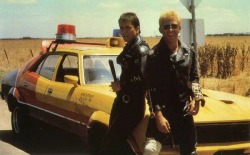Mad Max (1979) – George Miller
Having not seen Mad Max before, there were quite a few aspects of the film that somewhat took me by surprise and that I find immensely significant, and I think are here worth mentioning.
1) The costume design: the costume design in Mad Max is incredible, giving visual manifestation to both the characters personalities and positions within society. The costumes create a great comparison between Max and the rest of the highway patrol style police force, and the bikie gang. The gang tend to be severely dishevelled with ripped and torn clothing, crazy hair to match their crazy antics, including pieces of fur, which the audience could assume with some level of assurance came as a result of their wreaking havoc. It also plays an integral part in the transformation of Max throughout the duration of the film, whilst still in a mainly all leather outfit, it changes evidently to suit his position and motivations in life, his transforming attitude.
2) The level of violence:
a) The scene where Jess and child get run down on the highway – I think the main thing that struck me about this scene was that the violence was not overtly shown on screen, but in a more indirect way, leaving the actual climax of the scene to the imagination, without leaving any question about what did happen, just the way one visualises it. Meaghan suggests this too, stating how some scenes within Mad Max function “more by suggestion than showing, our imagination excessively completes the scene” (pg 241).
b) The scene at the beginning where the gang invade the town then destroy the young couple and their car – particularly because it is so early within the film, and there is no real preparation of the audience for the violence at hand. The main thing that affected me was that it seemed so unprovoked and graphic, but was important in reflecting the representation of the bikie gang, and the destruction they can cause, not necessarily if need be, but when they feel inclined. This notion can be interpreted as just as terrifying as the physical violence itself.
3) The way in which Max can’t escape that the road is the only home he has left: this can be looked at within the discourse of road films, where the search for the ultimate solution is home, where although the journey is essential to the narratives; its purpose is to inevitably end up somewhere. In this context, Mad Max then portrays a story where Max has nowhere to turn to, nowhere to be himself and find comfort, except the road. This is because his wife and child are brutally murdered, so therefore coming back to the physical home lifestyle he had before is not quite a real option, and he can’t bear the reality of it. His other option, the workplace, has also being jeopardised by the bikie gang, after killing his best mate, colleague and companion, he both realises staying there will just lead the gang straight to him, and he is motivated to take a break in fear of being targeted. He also has the ability to identify that there is not much differentiating them from the gang on the road except the badge and title they hold. With the two main parts of his life exhausted, work and home, where else could Max really go? The road has always being a part of him, and now with enough motivation to justify enacting revenge, he takes to the road, which in the end, really becomes him.
1) The costume design: the costume design in Mad Max is incredible, giving visual manifestation to both the characters personalities and positions within society. The costumes create a great comparison between Max and the rest of the highway patrol style police force, and the bikie gang. The gang tend to be severely dishevelled with ripped and torn clothing, crazy hair to match their crazy antics, including pieces of fur, which the audience could assume with some level of assurance came as a result of their wreaking havoc. It also plays an integral part in the transformation of Max throughout the duration of the film, whilst still in a mainly all leather outfit, it changes evidently to suit his position and motivations in life, his transforming attitude.
2) The level of violence:
a) The scene where Jess and child get run down on the highway – I think the main thing that struck me about this scene was that the violence was not overtly shown on screen, but in a more indirect way, leaving the actual climax of the scene to the imagination, without leaving any question about what did happen, just the way one visualises it. Meaghan suggests this too, stating how some scenes within Mad Max function “more by suggestion than showing, our imagination excessively completes the scene” (pg 241).
b) The scene at the beginning where the gang invade the town then destroy the young couple and their car – particularly because it is so early within the film, and there is no real preparation of the audience for the violence at hand. The main thing that affected me was that it seemed so unprovoked and graphic, but was important in reflecting the representation of the bikie gang, and the destruction they can cause, not necessarily if need be, but when they feel inclined. This notion can be interpreted as just as terrifying as the physical violence itself.
3) The way in which Max can’t escape that the road is the only home he has left: this can be looked at within the discourse of road films, where the search for the ultimate solution is home, where although the journey is essential to the narratives; its purpose is to inevitably end up somewhere. In this context, Mad Max then portrays a story where Max has nowhere to turn to, nowhere to be himself and find comfort, except the road. This is because his wife and child are brutally murdered, so therefore coming back to the physical home lifestyle he had before is not quite a real option, and he can’t bear the reality of it. His other option, the workplace, has also being jeopardised by the bikie gang, after killing his best mate, colleague and companion, he both realises staying there will just lead the gang straight to him, and he is motivated to take a break in fear of being targeted. He also has the ability to identify that there is not much differentiating them from the gang on the road except the badge and title they hold. With the two main parts of his life exhausted, work and home, where else could Max really go? The road has always being a part of him, and now with enough motivation to justify enacting revenge, he takes to the road, which in the end, really becomes him.


 RSS Feed
RSS Feed